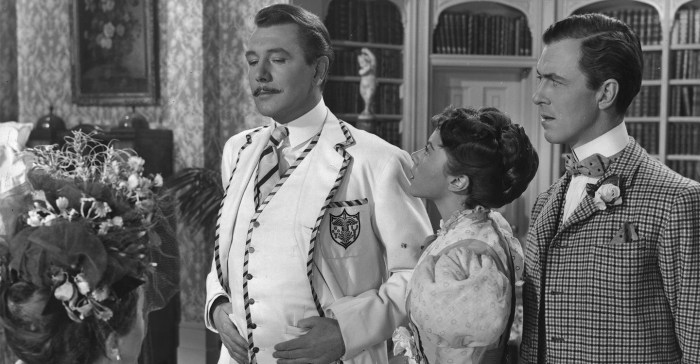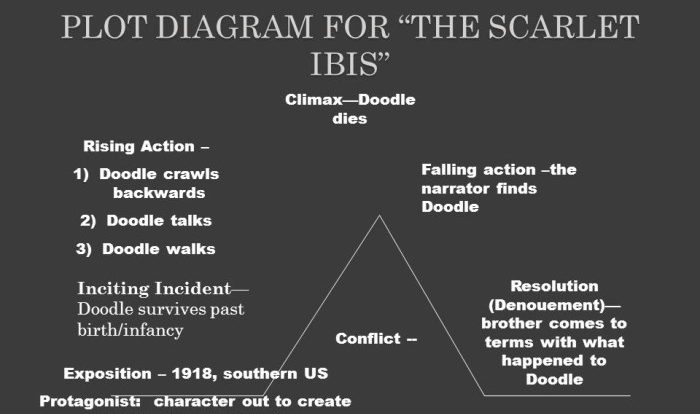The Lord of the Flies plot diagram is a comprehensive overview of the key events and turning points in the novel. It provides a clear and concise understanding of the story’s structure and development, from the initial exposition to the final resolution.
The diagram helps readers visualize the progression of the plot, identify the major conflicts and themes, and appreciate the author’s craftsmanship in weaving a compelling narrative.
Introduction
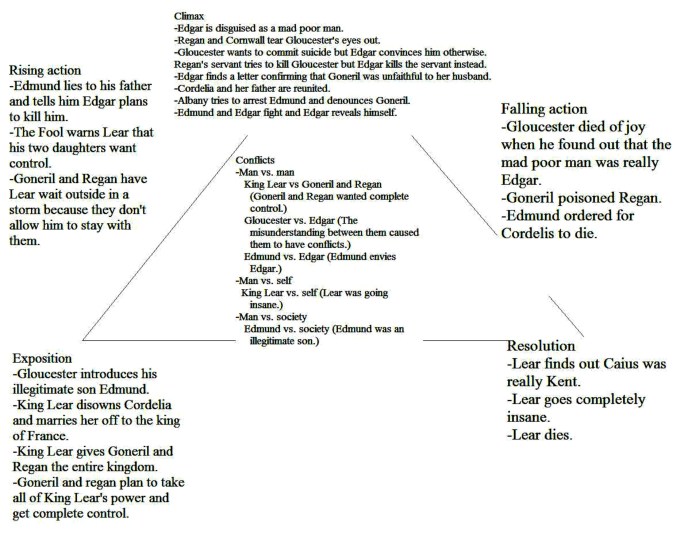
A plot diagram is a graphical representation of the structure of a story. It shows the key elements of the plot and how they are related to each other. The five key elements of a plot diagram are:
Exposition
The exposition introduces the setting, characters, and conflict of the story.
Rising action
The rising action is the series of events that lead to the climax of the story.
Climax
The climax is the turning point of the story, where the conflict is resolved.
Falling action
The falling action is the series of events that follow the climax and lead to the resolution of the story.
Resolution
The resolution is the final outcome of the story.Plot diagrams can be used to analyze the structure of a story and to identify the key events that drive the plot forward.
Exposition
The exposition of Lord of the Fliesestablishes the initial setting, introduces the main characters, and sets up the central conflict.
The story is set on a deserted island in the Pacific Ocean, where a group of British schoolboys have been stranded after their plane crashes. The boys range in age from six to twelve, and they come from a variety of backgrounds.
The most prominent characters include Ralph, Piggy, Jack, and Simon.
Setting
- Deserted island in the Pacific Ocean
- Dense jungle, white-sand beaches, coral reef
- No adults present
Characters
- Ralph:Elected leader of the boys; represents order and civilization
- Piggy:Intelligent and overweight; represents intellect and reason
- Jack:Leader of the hunters; represents savagery and violence
- Simon:Intuitive and spiritual; represents the voice of reason
Conflict
The central conflict of the novel arises from the clash between Ralph’s and Jack’s opposing views on how to govern the island. Ralph believes in establishing a society based on rules and order, while Jack advocates for a life of freedom and savagery.
Rising Action: Lord Of The Flies Plot Diagram
The rising action of Lord of the Fliesencompasses the events that lead to the climax of the novel. These events create a sense of tension and suspense, driving the plot towards its inevitable conclusion.
The initial incident that triggers the rising action is the plane crash that strands the group of boys on the island. The boys’ excitement and initial attempts at self-governance gradually deteriorate as they succumb to their primal instincts.
Conflict and Division
The rising action is characterized by a series of conflicts and divisions among the boys. Ralph, the elected leader, represents order and civilization, while Jack, the leader of the hunters, represents savagery and instinct. The conflict between these two forces escalates as the boys struggle to maintain a semblance of society on the island.
Violence and Fear
As the conflict intensifies, the rising action becomes increasingly violent. Jack’s group of hunters turns on Ralph’s followers, leading to a series of confrontations and deaths. The boys’ fear of the unknown, represented by the mysterious “beast,” further heightens the tension and suspense.
Loss of Innocence
The rising action of Lord of the Fliesalso depicts the gradual loss of innocence among the boys. As they become accustomed to the harsh realities of the island, they abandon their childhood ideals and embrace their darker impulses. This loss of innocence is a central theme of the novel and contributes to the growing sense of despair and hopelessness.
Climax
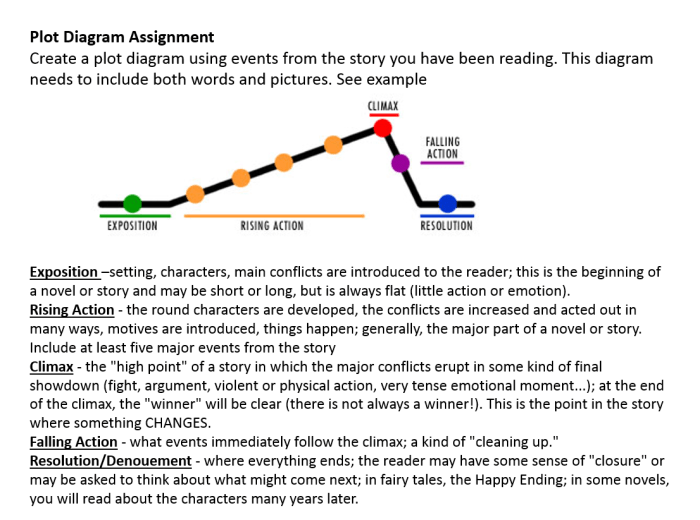
The climax, the turning point of the story, marks a significant shift in the narrative. It’s the moment where the conflict reaches its peak, leading to a resolution that transforms the characters and the plot.
In Lord of the Flies, the climax occurs when Simon confronts the Lord of the Flies, a representation of the boys’ inner savagery. Simon’s encounter with the Lord of the Flies reveals the true nature of the conflict: the struggle between civilization and savagery within the boys themselves.
The lord of the flies plot diagram depicts the gradual descent into chaos and savagery. For a break from the intensity, check out the cribbs kitchen burger cook off . Their mouthwatering burgers will surely satisfy your cravings. Returning to the plot diagram, it’s a fascinating study of human nature and the consequences of unchecked power.
Resolution of Conflict
The climax resolves the conflict by forcing the boys to confront their own darkness. Simon’s death at the hands of the boys symbolizes the triumph of savagery over civilization. However, the death also serves as a wake-up call for the remaining boys, who are horrified by their actions.
Character Transformation
The climax leads to significant character transformations. Ralph, the former leader, becomes disillusioned and retreats into himself. Piggy, the voice of reason, is killed by Roger, symbolizing the silencing of rationality. Jack, the embodiment of savagery, gains complete control over the group.
Falling Action
The falling action of Lord of the Fliesencompasses the events that follow the climax, the death of Simon. These events reveal the gradual disintegration of the boys’ society and their descent into savagery.
As the survivors grapple with the aftermath of Simon’s murder, they become increasingly fearful and suspicious of each other. The island’s once-orderly society has fractured, replaced by a chaotic and violent atmosphere.
The Descent into Chaos
- The boys divide into two factions: Jack’s hunters and Ralph’s supporters.
- Jack’s group becomes increasingly violent, raiding Ralph’s camp and stealing their supplies.
- The island becomes a battleground, with the boys engaging in primitive warfare.
The Rescue and Aftermath, Lord of the flies plot diagram
Amidst the chaos, a British naval officer arrives on the island. The officer is shocked by the boys’ behavior and quickly restores order.
The boys are rescued and return to civilization, but the experience on the island has left a profound impact on them. They have witnessed the fragility of human nature and the ease with which society can descend into barbarism.
Resolution
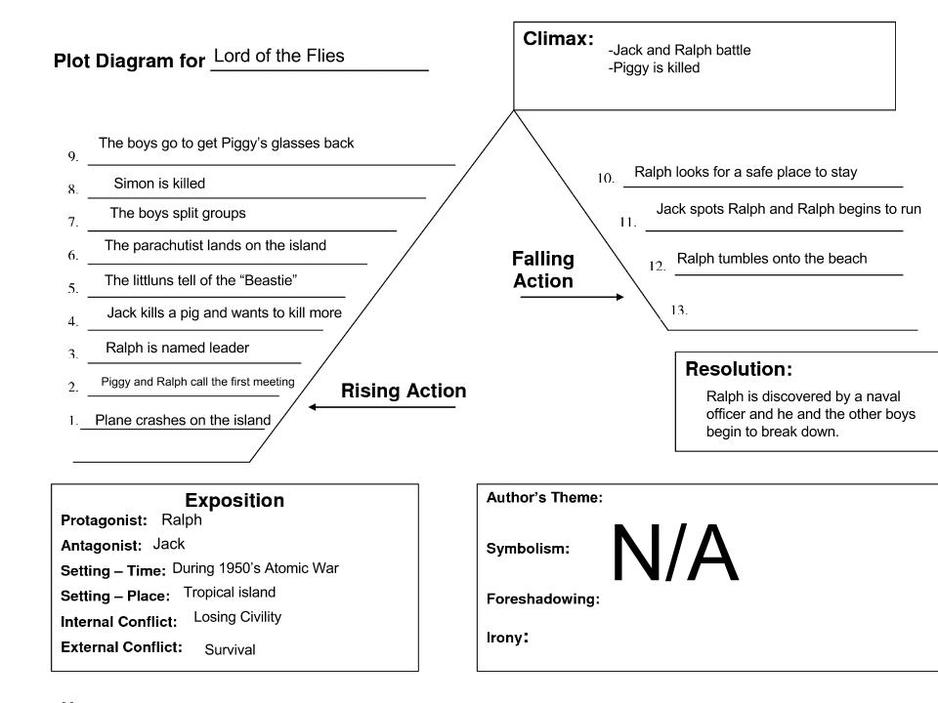
The resolution is the final outcome of the story, providing closure and leaving the reader satisfied. It resolves the conflicts and tensions that have been building throughout the narrative, offering a sense of completion and resolution.
The resolution may involve the protagonist achieving their goals, overcoming obstacles, or learning valuable lessons. It can also involve the resolution of conflicts between characters, the establishment of new relationships, or the discovery of important truths.
Closure in the Resolution
Closure is an important aspect of the resolution, as it provides a sense of completion and satisfaction for the reader. The resolution should tie up loose ends, resolve unanswered questions, and provide a sense of closure for the characters and their journey.
- Ties up loose ends:The resolution should address all the major plot points and conflicts, leaving no significant questions unanswered.
- Resolves unanswered questions:The resolution should provide answers to any lingering questions that the reader may have about the story and its characters.
- Provides a sense of closure for the characters:The resolution should provide a sense of closure for the characters, allowing them to move on from their past experiences and embrace the future.
Table of Plot Elements
To provide a comprehensive overview of the novel’s structure, we present a table outlining the key elements of the plot diagram, along with specific examples from the story.
Exposition
The exposition sets the stage for the story by introducing the characters, setting, and initial conflict.
| Element | Example |
|---|---|
| Characters | A group of British schoolboys, including Ralph, Piggy, Jack, and Simon |
| Setting | A remote, uninhabited island in the Pacific Ocean |
| Conflict | The boys must learn to survive and establish a society on their own |
Common Queries
What is the purpose of a plot diagram?
A plot diagram is a visual representation of the key events and turning points in a story. It helps readers understand the structure and progression of the plot, identify conflicts and themes, and appreciate the author’s craftsmanship.
What are the key elements of a plot diagram?
The key elements of a plot diagram typically include exposition, rising action, climax, falling action, and resolution.
How can a plot diagram help me analyze a novel?
A plot diagram can help you analyze a novel by providing a structured framework for examining the story’s elements, tracing its trajectory, and gaining insights into its underlying themes and messages.
